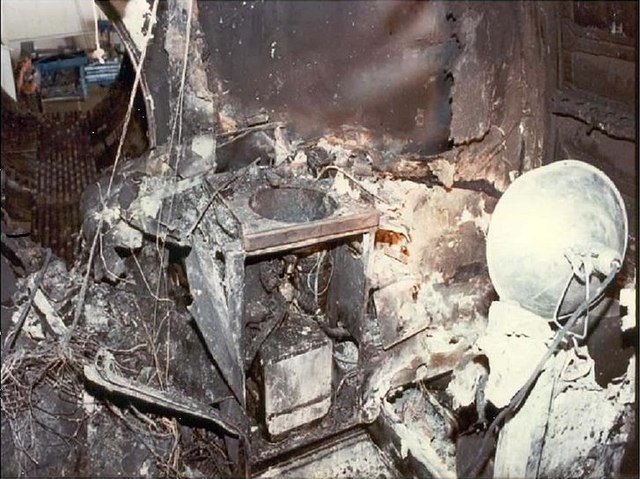Top Qs
Timeline
Chat
Perspective
In-flight fire
Aviation accident involving fire From Wikipedia, the free encyclopedia
Remove ads
In aviation, an in-flight fire is a type of aviation accident where an aircraft catches on fire in-flight. They are considered one of the most dangerous hazards in aviation, with a report from the British Civil Aviation Authority showing that after a fire on an aircraft starts, flight crews only have on average 17 minutes to land their aircraft before it becomes uncontrollable.[1] Between 1981 and 1990, approximately 20% of all fatalities on US airlines were caused by in-flight fires.[2]

Remove ads
Types
- Cabin fire – A fire in the passenger cabin.[3]
- Cargo fire – A fire inside the cargo hold.[4]
- Cockpit fire – A fire in the cockpit.[5]
- Electrical fire – A fire occurring from electrical wires or other electrical systems.[6]
- Engine fire – A fire inside of an aircraft engine.[6]
Causes and spread
Summarize
Perspective

Electrical fires are often the result of rogue sparks or the overheating of electronic components. If there are flammable materials around the source of the fire, an electrical fire can quickly spread.[7] Cockpit fires are often related to electrical fires as there many electrical components inside the cockpit that can produce sparks. If a cockpit fire is not extinguished in time, the smoke and fire on the controls could make controlling the aircraft harder.[5]
Fires in the cabin can be caused by items that the passengers bring on board, like personal electronic devices, lithium batteries, cigarettes, and can be exacerbated by improper waste management. Electrical fires can also occur in the cabin area from wires that run through the cabin, like those for in-flight entertainment systems.[8]
Depending on what's inside the cargo hold of an aircraft, a cargo fire can quickly spread. For example, lithium batteries can undergo a process called thermal runaway, where the battery is able to serve as a source of heat, fuel, and an oxidizing agent.[9][10] Other hazardous cargo include items that can serve as an oxidizing agent, like oxygen bottles and cleaning products.[9]
Engines failures, mainly from loss of engine oil and uncontained engine failures, are the main cause of engine fires.[6] In these scenarios, the excess heat produced could ignite the jet fuel or jet fuel vapors inside the engine.[7]
In cases where a fire burns for a sufficient time, an event called a flashover can occur. A flashover is the near simultaneous ignition of any combustible material within an enclosed area. As more flammable gasses are released when materials burn and the temperature rises, the autoignition temperature is eventually reached, causing everything in the enclosed space to ignite.[11] Temperatures of flashovers can reach 480–650 °C (900–1,200 °F), making them unsurvivable for more than a few seconds.[12]
Prevention
Since 1985, the Federal Aviation Administration (FAA) has mandated more fire-resistant materials to be used in aircraft to lengthen the amount of time until a flashover occurs.[13] A kerosene burner test for aircraft seats is used to validate their resistance to the type of fuel fire most commonly encountered; developments in fire-resistant foam and fire-blocking layers have adding 40 to 60 seconds of time for passengers to escape the aircraft.[2] Since 1986, aircraft cargo compartments have been required to have more fire-resistant lining and in 1998, the compartments were to have fire detection and suppression systems.[14] Halon fire extinguishers, generally using Halon 1301, are used widely throughout the aviation industry because of their high performance to weight ratio.[15] Due to its ozone depleting nature,[15] aviation fire-suppression systems are one of the last remain permitted uses of halon.[16]
Remove ads
Notable examples
Remove ads
Notes
- This represents where the fire first started, even if it ended up elsewhere in the aircraft
- A total of 125 people were killed as one person was killed on the ground
- A total of 113 people were killed as four people were killed on the ground
References
External links
Wikiwand - on
Seamless Wikipedia browsing. On steroids.
Remove ads
